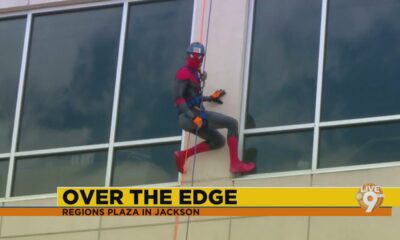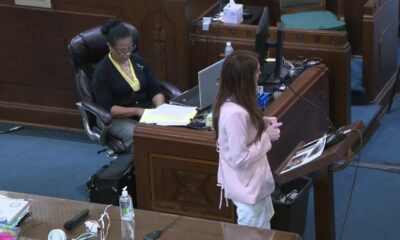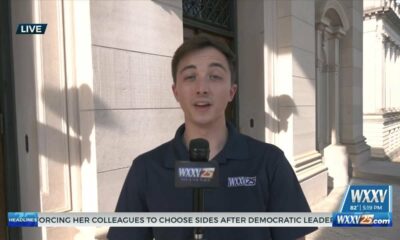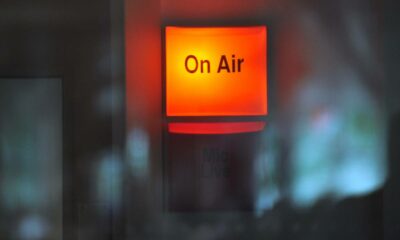Kaiser Health News
Back From COP28, California Climate Leaders Talk Health Impacts of Warming
Samantha Young
Mon, 05 Feb 2024 10:00:00 +0000
SACRAMENTO, Calif. — Wildfire smoke. Drought. Brutal heat. Floods. As Californians increasingly feel the health effects of climate change, state leaders are adopting sweeping policies they hope will fend off the worst impacts — and be replicated by other countries.
Several of them attended the United Nations Framework Convention on Climate Change, known as COP28, late last year, where more than 120 countries signed a declaration acknowledging the growing health impacts of climate change and their responsibility to keep people safe.
“Leaders from around the world are coming to these climate negotiations understanding that climate change is both killing and hurting their people,” said Wade Crowfoot, secretary of the California Natural Resources Agency, who represented California in Dubai.
In August and September 2020 alone, when dozens of wildfires burned around California, as many as 3,000 older residents may have died from wildfire smoke-related causes, according to estimates from Stanford University researchers.
California has taken steps on its own to address climate change and cut greenhouse gas emissions, such as banning the sale of new gas-powered cars and light trucks by 2035 and requiring utilities to provide a growing share of electricity from renewable sources like wind and solar. The policies are intended to reduce the state's air pollution, which consistently ranks among the worst in the nation — especially in the San Joaquin Valley and the Los Angeles basin — and contributes to the premature deaths of thousands of Californians annually.
Regulators estimate California's climate policies could reduce the cost of hospitalizations, asthma cases, and lost work and school days by $199 billion in 2045 alone.
“If we don't take action, it has an impact on public health. It also has a massive economic impact,” said Liane Randolph, who chairs the California Air Resources Board and also attended the conference.
Crowfoot, Randolph, and another attendee, Christina Snider-Ashtari, Democratic Gov. Gavin Newsom's Tribal Affairs secretary, spoke with KFF Health News senior correspondent Samantha Young to explain how California is trying to keep its nearly 40 million residents safe. The interviews have been edited for length and clarity.
Q: What is the biggest health threat that climate change poses for Californians, and what is the state doing about it?
Randolph: The biggest challenges are extreme heat and wildfire smoke. And climate change is making the existing health threats worse. For example, heat increases ozone pollution. What is happening is that high-heat days are becoming more common. And while we have reduced ozone levels and nitrogen oxides in the atmosphere, we still end up with days where air quality levels are exceeded because we have more high-heat days that create additional smog.
We have a comprehensive document, called the Scoping Plan, to tackle climate change. The key piece of it is reducing the combustion of fossil fuels because those have public health impacts on the ground for air quality and they have climate impacts. We are moving to zero-emission vehicles, moving to renewable energy, moving to zero-emission space and water heaters. All of these strategies move us away from the combustion of fossil fuels.
California itself cannot tackle climate change worldwide, but what we can do is support new technologies that can then be replicated, ideally, around the country and around the world. We're encouraging the development of zero-emission vehicles all the way from passenger vehicles to heavy-duty vehicles. We're fostering the market for technologies like heat pumps that allow people to heat and cool their homes without using gas. All of these things need to get support and have a market. We can create markets that can percolate through the rest of the world.
Snider-Ashtari: Many tribes have been relocated to places that don't have good access to water, and that was by design, by the federal government and the state. So, tribes are already in places where it's designed to be inhospitable to life. As things get worse, and there are more stressors, less water, hotter summers, Indian Country are these islands of vulnerability within California.
A lot of our ancestral food sources that tribes have relied on are either not there or they are there at the wrong time of year. Salmon populations are on the decline. Native people can't access abalone right now because of ocean acidification and overharvesting. The same thing with seaweed, which is a major supplement to diets. With certain species not able to thrive in a changing climate, you're just not going to be able to get the same kind of nutrition in rural California that you would in other places. We will have bigger impacts on the health stressors that Native people already suffer from, like diabetes at higher rates.
One of the things that we've been looking at with tribes is reintroducing traditional practices to address climate issues. We've been reintegrating cultural burning practices so the smoke will clear out invasive pests and make sure the forest floor is healthy. We can promote forest health to prevent large-scale wildfires, which leads to the pumping of carbon into the atmosphere, and we can create better crops for Native people so they can have their critical food sources. Tribes aren't going anywhere. The rest of us could move anywhere we want, but tribes — these are our ancestral homelands.
Crowfoot: We are experiencing multiple overlapping health threats. Wildfire, drought, and extreme heat cost lives in California. Wildfire gets a lot of attention, particularly when it's barreling down on communities, which is a major danger. But less discussed are the smoke impacts from wildfire. During our worst wildfire seasons, weeks of dangerous air blanket the state. For Californians that have preexisting medical conditions, for the elderly, for kids, that is really dangerous.
As it relates to drought, several hundred thousand Californians lose their access to water in their homes during drought because they're on shallow groundwater wells. That's a major health impact in the most vulnerable, poorest, most isolated communities in California. And then there's extreme heat. It's now the biggest climate-driven killer in California and other parts of the world.
Building our resilience to these climate impacts is a matter of health and safety. We have really clear action plans. We have one on water resilience, specifically on water supply and how we're going to supplant the loss of water supply in the next two decades. We have one on wildfire. Not only are we improving the ability to fight wildfires, but we're spending a ton of money protecting communities, improving landscapes. And we have an Extreme Heat Action Plan to improve protections for people, everything from noticing when extreme heat is bearing down, providing places of refuge in communities where people don't have air conditioning, and trying to get more shade cover at schools and on the streets.
This article was produced by KFF Health News, which publishes California Healthline, an editorially independent service of the California Health Care Foundation.
——————————
By: Samantha Young
Title: Back From COP28, California Climate Leaders Talk Health Impacts of Warming
Sourced From: kffhealthnews.org/news/article/cop28-california-climate-leaders-health-impacts-warming-wildfire-smoke-water/
Published Date: Mon, 05 Feb 2024 10:00:00 +0000
Did you miss our previous article…
https://www.biloxinewsevents.com/congressman-off-base-in-ad-claiming-fauci-shipped-covid-to-montana-before-the-pandemic/
Kaiser Health News
DIY Gel Manicures May Harm Your Health
Tarena Lofton
Thu, 02 May 2024 09:00:00 +0000
A fresh set from the comfort of your own home? DIY gel nails have been all the rage on social media, but the practice could cause you to develop a life-changing allergy. In a TikTok video, creator @alina.gene describes developing an acrylate allergy from doing gel nails at home. Now, when exposed to acrylates, the creator feels severe pain.
The creator warns viewers not to self-apply nail polish that requires a UV light to cure. In later videos, @alina.gene explains that at-home use differs from in-salon use because salon professionals have access to higher-quality chemicals that are less likely to cause reactions and that they also have proper training on how to safely apply the products.
“I know I sound real dramatic because an allergy to gel nails or even an allergy to acrylates isn't going to kill you, but the thing is, in the wrong situation it could prevent you from getting lifesaving medical care,” said @alina.gene in another video. Common medical products contain acrylates, and developing this allergy can cause major issues in obtaining future medical care.
We asked an allergist to walk us through this viral video.
If you enjoyed this story from the KFF Health News social team, follow us on Instagram @KFFHealthNews.
✍️: KFF Health News Audience Engagement Team
——————————
By: Tarena Lofton
Title: DIY Gel Manicures May Harm Your Health
Sourced From: kffhealthnews.org/news/article/diy-gel-manicures-health-risks/
Published Date: Thu, 02 May 2024 09:00:00 +0000
Did you miss our previous article…
https://www.biloxinewsevents.com/robert-f-kennedy-jr-is-wrong-about-a-ban-on-nih-research-about-mass-shootings/
Kaiser Health News
Robert F. Kennedy Jr. Is Wrong About a Ban on NIH Research About Mass Shootings
Louis Jacobson, PolitiFact
Thu, 02 May 2024 09:00:00 +0000
“Congress prohibits the NIH from researching the cause of mass shootings.”
Robert F. Kennedy Jr. in an April 21 post on X
The National Institutes of Health is the federal government's main agency for supporting medical research. Is it barred from researching mass shootings? That's what presidential candidate Robert F. Kennedy Jr. said recently.
Kennedy, whose statements about conspiracy theories earned him PolitiFact's 2023 “Lie of the Year,” is running as an independent third-party candidate against President Joe Biden, the presumptive Democratic candidate, and the presumptive Republican nominee, former President Donald Trump.
On April 21 on X, Kennedy flagged his recent interview with conservative commentator Glenn Beck, which touched on gun policy. Kennedy summarized his gun policy views in the post, writing, “The National Institutes of Health refuses to investigate the mystery; in fact, Congress prohibits the NIH from researching the cause of mass shootings. Under my administration, that rule ends — and our kids' safety becomes a top priority.”
But this information is outdated.
In 1996, Congress passed the “Dickey Amendment,” an appropriations bill provision that federal officials widely interpreted as barring federally funded research related to gun violence (though some observers say this was a misinterpretation). Congress in 2018 clarified that the provision didn't bar federally funded gun-related research, and funding for such efforts has been flowing since 2020.
Kennedy's campaign did not provide evidence to support his statement.
What Was the Dickey Amendment?
After criticizing some federally funded research papers on firearms in the mid-1990s, pro-gun advocates, including the National Rifle Association, lobbied to halt federal government funding for gun violence research.
In 1996, Congress approved appropriations bill language saying that “none of the funds made available for injury prevention and control at the Centers for Disease Control and Prevention may be used to advocate or promote gun control.” The language was named for one of its backers, Rep. Jay Dickey (R-Ark).
But the Dickey Amendment, as written, did not ban all gun-related research outright.
“Any honest research that was not rigged to produce results that helped promote gun control could be funded by CDC,” said Gary Kleck, a Florida State University criminologist. But CDC officials, experts said, interpreted the Dickey Amendment as banning all gun-related research funding.
This perception meant the amendment “had a chilling effect on funding for gun research,” said Allen Rostron, a University of Missouri-Kansas City law professor who has written about the amendment. Federal agencies “did not want to take a chance on funding research that might be seen as violating the restriction” and so “essentially were not funding research on gun violence.”
Also, the Dickey Amendment targeted only the CDC, not all other federal agencies. Congress expanded the restriction to cover NIH-funded research in 2011.
Although the Dickey Amendment didn't bar gun-related research, federal decision-makers acted as though it did by not pursuing such research.
Moving Past the Dickey Amendment
Over time, critics of the gun industry made an issue of the Dickey Amendment and gathered congressional support to clarify the amendment.
In 2018, lawmakers approved language that said the amendment wasn't a blanket ban on federally funded gun violence research. By 2020, federal research grants on firearms began to be issued again, starting with $25 million to be split between the CDC and NIH.
By now, the CDC and NIH are funding a “large portfolio” of firearm violence-related research, said Daniel Webster, a professor at the Johns Hopkins Bloomberg School of Public Health.
Also, the Justice Department's National Institute of Justice has funded the largest study of mass shootings to date, Webster said, and is seeking applications for studies of mass shootings.
Our Ruling
Kennedy said, “Congress prohibits the NIH from researching the cause of mass shootings.”
Although the Dickey Amendment, a provision of appropriations law supported by the gun industry, didn't prohibit all federally supported, gun-related research from 1996 to 2018, decision-makers acted as though it did.
However, in 2018, Congress clarified the provision's language. And since 2020, CDC, NIH, and other federal agencies have funded millions of dollars in gun-related research, including studies on mass shootings.
We rate Kennedy's statement False.
Our Sources
Robert F. Kennedy Jr. post on X, April 21, 2024
National Institutes of Health, “NIH Awards Additional Research and Training Grants to Support Firearm Injury and Mortality Prevention Science,” Sept. 20, 2023
National Institute of Justice, “Public Mass Shootings: Database Amasses Details of a Half Century of U.S. Mass Shootings with Firearms, Generating Psychosocial Histories,” Feb. 3, 2022
National Institute of Justice, “NIJ FY24 Research and Evaluation on Firearm Violence and Mass Shootings,” Feb. 5, 2024
Centers for Disease Control and Prevention, “Funded Research,” accessed April 22, 2024
American Psychological Association, “A Thaw in the Freeze on Federal Funding for Gun Violence and Injury Prevention Research,” April 1, 2021
Allen Rostron, “The Dickey Amendment on Federal Funding for Research on Gun Violence: A Legal Dissection” (American Journal of Public Health), July 2018
Email interview with Gary Kleck, a Florida State University criminologist, April 22, 2024
Email interview with Daniel W. Webster, professor at the Johns Hopkins Bloomberg School of Public Health, April 22, 2024
Email interview with Jaclyn Schildkraut, executive director of the Regional Gun Violence Research Consortium at the Rockefeller Institute of Government, April 22, 2024
Email interview with Mike Lawlor, University of New Haven criminologist, April 22, 2024
Email interview with Allen Rostron, University of Missouri-Kansas City law professor, April 22, 2024
KFF Health News is a national newsroom that produces in-depth journalism about health issues and is one of the core operating programs at KFF—an independent source of health policy research, polling, and journalism. Learn more about KFF.
USE OUR CONTENT
This story can be republished for free (details).
——————————
By: Louis Jacobson, PolitiFact
Title: Robert F. Kennedy Jr. Is Wrong About a Ban on NIH Research About Mass Shootings
Sourced From: kffhealthnews.org/news/article/fact-check-rfk-jr-wrong-nih-research-mass-shootings-gun-control-dickey-amendment/
Published Date: Thu, 02 May 2024 09:00:00 +0000
Did you miss our previous article…
https://www.biloxinewsevents.com/breaking-a-promise-california-deficit-could-halt-raises-for-disability-workers/
Kaiser Health News
‘Breaking a Promise’: California Deficit Could Halt Raises for Disability Workers
Vanessa G. Sánchez
Thu, 02 May 2024 09:00:00 +0000
SACRAMENTO, Calif. — Families of people with intellectual and developmental disabilities say Gov. Gavin Newsom is reneging on a scheduled raise for the workers who care for their loved ones, and advocates warn of potential lawsuits if disability services become harder to get.
Citing California's budget deficit, the Democratic governor wants to save around $613 million in state funds by delaying pay increases for a year for about 150,000 disability care workers. The state will forgo an additional $408 million in Medicaid reimbursements, reducing funding by over $1 billion.
Some lawmakers say this decision will increase staff turnover and vacancies, leaving thousands of children and adults with disabilities without critical services at home and in residential facilities. Disability advocates warn it could violate the Lanterman Act, California's landmark law that says the state must provide services and resources to people with disabilities and their families.
Newsom is “breaking a promise,” said Felisa Strickland, 60, who has been searching for more than a year for a day program for her 23-year-old daughter, Lily, who has autism and cerebral palsy. “It's creating a lot of physical and mental health problems for people, and it's a lot of undue stress on aging parent caregivers like myself.”
Disability care workers, known as direct support professionals, provide daily, hands-on caregiving to help children and adults with intellectual and developmental disabilities, such as autism, cerebral palsy, and epilepsy, remain independent and integrated into their communities.
In California, more than 400,000 people with disabilities need accommodation, and this population, along with seniors, is increasing. It's not clear how big the worker shortage is because the state hasn't released workforce data. As the demand for these workers grows generally, experts predict a shortage of between 600,000 and 3.2 million direct care workers by 2030.
Advocates say California pays most providers from $16 to $20 an hour, which meets the state's minimum wage but falls short of what some economists consider a living wage. In 2021, the state committed to raising wages after identifying a $1.8 billion gap between the rates received by nonprofits that contract with the state to provide care and the rates deemed adequate.
Thus far, the state has provided around half that total, most of which has gone to raising wages and benefits. Workers had been expecting one more increase, of $2-$4 an hour, in July, until Newsom proposed a delay.
Also, nonprofits say California has made it harder to compete for workers after raising wages in other service and health industries. Newsom approved a $20 minimum wage for fast-food workers that went into effect in April and he struck a deal last year with unions and hospitals to begin raising health care workers' wages to a minimum of $25 an hour.
Ricardo Zegri said Taco Bell would pay him more than the $19 an hour he makes as a disability care worker in a supervisory position.
“Every paycheck, it's a discussion at home about what bills we need to prioritize and whether it's time to start looking for work that pays more,” said Zegri, who works a second job as a musician in the San Francisco Bay Area.
Newsom wants to preserve key health initiatives, including the state expansion of Medi-Cal to low-income immigrants regardless of legal status, and CalAIM, an ambitious $12 billion experiment to transform Medi-Cal into both a health insurer and a social services provider. However, the rate delay for providing disability care is the largest savings in the Health and Human Services budget as Newsom and legislative leaders look to cuts, delays, and shifts in funding to close a deficit estimated between $38 billion and $73 billion.
Dozens of legislators from both parties are asking Newsom and legislative leaders to preserve the increase. Assembly member Stephanie Nguyen, a Democrat from Elk Grove, signed a letter supporting the raise. Although lawmakers are negotiating with the administration, she said reversing the decision to delay the pay boost is unlikely. Everybody “has to take a hit somewhere,” Nguyen said.
Krystyne McComb, a spokesperson for the Department of Developmental Services, said even though the state would lose federal matching funds this year, it would resume drawing funds when the state reinstates the plan in 2025.
The department did not respond to questions about how it plans to retain workers and fill vacancies.
Newsom's proposal risks a collapse of the disability service system, which would violate the Lanterman Act and make the state vulnerable to lawsuits, said Jordan Lindsey, executive director of the Arc of California, a statewide disability rights advocacy organization.
Families say the state has already fallen short on services they need. Strickland quit her job to care for Lily, the Santa Barbara mother said. “It's not reasonable to expect someone to care for somebody else 24 hours a day, seven days a week,” she said.
Lily graduated from high school and in 2022 completed a program that prepares youth with disabilities to transition into adult life. She had been looking forward to joining a day program to make new friends but has yet to find a spot. And due to a shortage of workers, Lily receives only four hours a week at home with a provider, who is paid around $16 an hour.
When Lily hangs out with the provider, her demeanor changes to the happy person she used to be, Strickland said.
“The system is already in crisis,” she said. “There are tons and tons of people that are sitting at home because there's nowhere for them to go.”
——————————
By: Vanessa G. Sánchez
Title: ‘Breaking a Promise': California Deficit Could Halt Raises for Disability Workers
Sourced From: kffhealthnews.org/news/article/california-disability-worker-pay-delay-deficit/
Published Date: Thu, 02 May 2024 09:00:00 +0000
-
Mississippi Today4 days ago
On this day in 1951
-
Mississippi News5 days ago
One injured in Mississippi officer-involved shooting after chase
-
SuperTalk FM3 days ago
Festival merger in Leland sets up one major event for Mississippi Delta
-
Mississippi News2 days ago
Two women accused of shoplifting across southeast captured in Mississippi
-
SuperTalk FM3 days ago
PERS bill set to phase in employer rate increase heads to governor’s desk
-
Mississippi Business1 day ago
Geartek expanding operations in Alcorn County
-
Mississippi News Video7 days ago
Vehicle fire blocks all lanes of I-55 South in Hinds County
-
SuperTalk FM6 days ago
Investigation underway after gun found in backpack of Ridgeland High School student







































